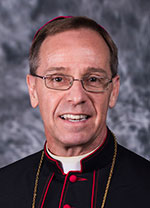Christ the Cornerstone
The pope’s cathedral, a visible symbol of the universal Church

On Sunday, Nov. 9, the Church’s liturgical schedule is interrupted. Instead of observing the Thirty-Second Sunday in Ordinary Time, the Church invites us to celebrate the Feast of the Dedication of the Lateran Basilica, the cathedral of the Diocese of Rome.
We don’t normally celebrate church buildings. In fact, as noted in my recent pastoral reflection on Peace and Unity, “Beyond any institution or building, the Church is the community of believers which is missionary by its very nature.”
We insist that the Church of Jesus Christ is much more than any institution or building, and yet we reverence the sacred spaces where we encounter the person of Jesus, especially in the Holy Sacrifice of the Mass.
The Basilica of St. John Lateran in Rome is the pope’s cathedral and, therefore, the mother Church of Rome and of the world. The Lateran is a visible symbol of the universal Church. It calls us to look toward the heavenly house of God, which the earthly Church seeks on pilgrimage. As a sacred symbol (a sacramental), this particular church building calls our attention to the deeper meaning of “ecclesia,” the gathering of God’s holy people, the one Body of Christ.
The Gospel reading for the Feast of the Dedication of the Lateran Basilica (Jn 2:13-22), tells the familiar—even disturbing—story of Jesus’ “cleansing” of the Temple. As St. John tells us:
Since the Passover of the Jews was near, Jesus went up to Jerusalem. He found in the temple area those who sold oxen, sheep, and doves, as well as the money-changers seated there. He made a whip out of cords and drove them all out of the temple area, with the sheep and oxen, and spilled the coins of the money-changers and overturned their tables, and to those who sold doves he said, “Take these out of here, and stop making my Father’s house a marketplace.” His disciples recalled the words of Scripture, “Zeal for your house will consume me.” (Jn 2:13-17)
Those who have profaned the Temple are cast out because of their irreverence and indifference to the things of God. They are preoccupied with material things, and Jesus makes it clear that his Father’s house is a sacred place, not a marketplace.
St. John continues this story by quoting Jesus’ response to the Jews’ request for a sign—some evidence that he has the authority to decide who or what is appropriate for the Temple. How Jesus answers their demand is even more disturbing to the Jewish leaders: “Destroy this temple and
in three days I will raise it up” (Jn 2:19). Understandably, they find this astonishing. “This temple has been under construction for 46 years, and you will raise it up in three days?” (Jn 2:20)
But St. John tells us that Jesus was speaking about the temple of his Body. The Body of Christ is the new and eternal temple. No building can take the place of the resurrected Christ, who lives in and through the Church and that he nourishes with his Body and Blood in the Holy Eucharist. That’s why the Gospel of St. John concludes this powerful story by saying, “Therefore, when he was raised from the dead, his disciples remembered that he had said this, and they came to believe the Scripture and the word Jesus had spoken” (Jn 2:22).
We who are missionary disciples and pilgrims of hope are the Body of Christ, the Church. Far greater than any institution or building, we are the hands and feet, the minds and hearts, and the words and actions of our Lord Jesus Christ. We honor the sacred spaces that serve as gathering points. And we revere the holy places (tabernacles) where the Real Presence of Christ is found—waiting for us to come and adore him and to receive him in Holy Communion.
Church buildings like the Basilica of St. John Lateran in Rome are not honored for their own sakes, but for their role in gathering God’s people in unity and peace as the one Body of Christ.
Inside the Lateran Basilica, surrounding the central nave along the north and south walls, there are on display huge statues of the twelve Apostles bearing the instruments of their martyrdom.
These remind us powerfully that what is most important is not the building, despite its brilliant art and architecture, but the Mission entrusted to us all by Christ.
The Church’s Mission, instituted by Jesus, is the proclamation of the Good News with a focus on making missionary disciples of people of all nations without exception. As we near the end of this liturgical season, let’s rededicate ourselves to being the Body of Christ and carrying his message to all. †
